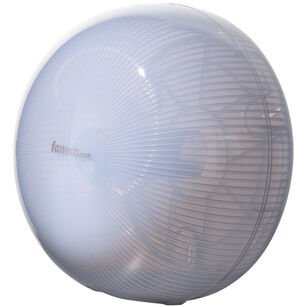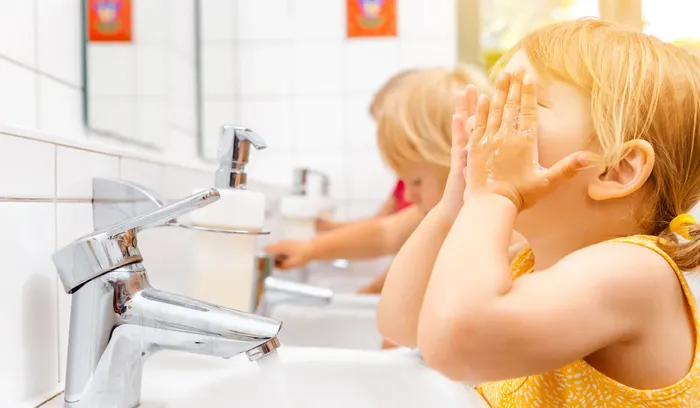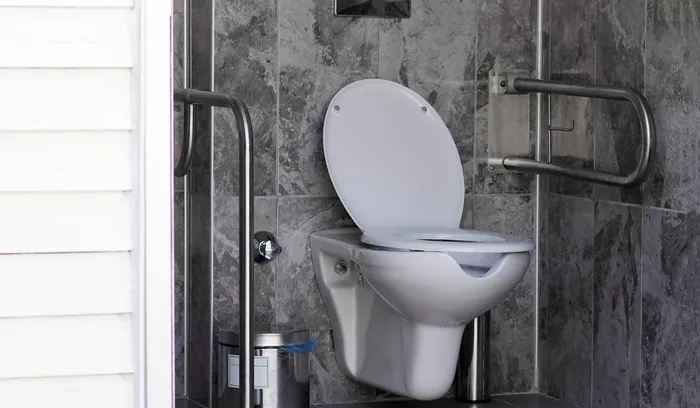School bathrooms - requirements, design, equipment

The design of every hygiene-sanitary room must consider its purpose. Due to the specific and demanding users, namely children, school bathrooms must meet not only specific hygiene standards. It is important for the bathroom to create a friendly space. This is influenced by the color and style in which the room is maintained, as well as the adaptation of individual bathroom fixtures to the age of the children using them. Moreover, infrastructure intended for children and adolescents must meet certain parameters and comply with specific standards. Only safe components with the appropriate certifications can be used for their creation.
 Photo: School bathroom design based on bright, creativity-stimulating colors.
Photo: School bathroom design based on bright, creativity-stimulating colors.
School Bathrooms
Staying in an educational institution is often a stressful experience—especially for young children. Therefore, every effort should be made to create a friendly environment, and this also applies to school bathrooms. This helps reduce the child’s stress levels and makes the entire school feel more approachable. As a result, designing bathrooms in schools is a significant challenge. These rooms must meet not only the requirements of the applicable regulations but also the needs of the children themselves. They should willingly use the toilets or the available accessories; this is a matter of hygiene, and thus health and safety. Therefore, all elements of the bathroom infrastructure in schools must not only be accessible but also user-friendly and adapted to the age of the children.
School Toilets - 2022 Requirements
The regulation on safety and hygiene in schools and educational institutions precisely defines the requirements for bathrooms in kindergartens and schools. These specify the number of sinks and urinals, as well as the overall number of toilets in a school. The 2020 regulations also emphasize the necessity of performing specific actions to prevent the spread of pathogens responsible for infectious diseases, including COVID-19.
Above all, according to the regulations, school toilets must provide students with constant access to running hot water, cleaning products, hand disinfectants, towels, and toilet paper. Additionally, sanitary cabins and bathroom fixtures must be adapted to the users' height. The regulations regarding bathrooms in kindergartens and schools also require that the cabins are equipped with a special lock that can be opened from the outside. This is a safeguard in case a child gets trapped inside—it allows a guardian to release them.
Product range made of ABS material, with rounded edges and PZH certification - the best choice for your facility / Photo: Faneco Products
Sanitary Guidelines for Schools
The guidelines created by the Sanitary Inspectorate for schools not only define the number of toilets, urinals, or sinks but also the height at which bathroom fixtures should be installed. In addition to the convenience of the children using them, it is particularly important to enable learning and maintaining personal hygiene. According to the sanitary regulations in schools, all accessories must allow for easy cleaning.
The Sanitary Inspectorate's guidelines for schools also specify how bathrooms for disabled individuals should be designed and how many there should be.
Number of Toilets in Schools
- According to the regulations, the number of toilets in a school must be such that there is one toilet bowl for every 20 girls.
- For boys, the number is the same, unless urinals are available in the bathroom. In that case, one toilet bowl for every 30 boys and one urinal for every 10 boys is sufficient.
- The height at which the toilets are installed primarily depends on the age of the children. For the 7-11 age group, the optimal height is 35 cm.
- For students between 12 and 15 years old, the height is 42 cm.
The regulations also define the number of toilets in schools that must be adapted to the needs of people with mobility impairments. There should be at least one specially adapted bathroom per floor accessible to disabled persons.
Number of Sinks in Schools
The necessary number of sinks in schools is the same as in other public buildings. There should be at least one sink for every 20 people in every bathroom.
Sink Height for Children
- Bathroom fixtures, such as sinks and toilets, must be installed at a height that allows children to use them comfortably.
- This aspect is also regulated by the regulations.
- The height at which sinks are installed for children primarily depends on their age, and consequently their height.
- For children aged 7-11 years, it is recommended to install sinks at a height of 65-75 cm.
- For the 12-15 age group, sinks should be installed at a height of 75-82 cm.
- As a general guideline, sinks installed at 60 cm for six-year-olds should be raised by 5 cm every two years.
 Photo: Children of different ages using sinks / Freepik
Photo: Children of different ages using sinks / Freepik
Urinal Height in Schools
- Just like with sinks and toilets, the height at which urinals should be installed in schools depends on the age of the students. For the 7-11 age group, they should be installed at a height of 50 cm.
- For students aged 12-15 years, the urinals should be installed at a height of 57 cm.
WC Cabin Dimensions in Schools
WC cabins in schools should be at least 150 cm long and 100 cm wide. Dividers between the individual cabins should be slightly lower than those intended for adults (200 cm). They should be made of non-absorbent, damage-resistant, and lightweight materials. In practice, cabins made of chipboard framed with aluminum profiles are commonly used. It should be remembered that the cabin doors should have openings that allow air circulation. Alternatively, the doors can be installed slightly higher so that the space underneath provides adequate ventilation.
School Bathroom Design
Designing a school bathroom is significantly different from arranging a similar space in private homes. Particular attention must be paid to ergonomics and the ease of keeping the various fixtures clean. The safety of the children using the bathroom is also especially important.
It is also crucial to use durable and tested technologies. This ensures that all the equipment will function for many years, helping to avoid the need for expensive renovations in the near future.
It’s important to note that not all aspects of school bathroom design are regulated by law. In these cases, it is advisable to focus on implementing the safest possible solutions. An example is using lock mechanisms with grip-lock handles in toilet cabins. This provides a safe and easy way to open doors. Additionally, in case of entrapment or emergency, the doors can be easily opened from the outside.
Other elements to consider include anti-slip flooring, especially in cabins and near sinks—basically, anywhere where water may be present on the floor, increasing the risk of slipping. Moreover, to encourage children to use the bathrooms and learn hygiene habits, it's worth ensuring that the doors, cabin dividers, and various accessories are aesthetically pleasing and colorful. This will make the bathroom a child-friendly space where they will enjoy spending time.
School Bathroom Equipment
The equipment in school bathrooms should not only facilitate hygiene for students but also be easy to keep clean and safe to use. An excellent solution is the use of sanitary fixtures with special antibacterial coatings. Rimless toilet bowls, which prevent the accumulation of dirt under the rim, are also a hygienic option.
Both sanitary ceramics, furniture, and additional accessories like hand dryers, paper towel dispensers, and soap dispensers should have rounded edges. This reduces the risk of serious injuries if someone slips. Anti-slip surfaces, such as textured floor tiles, further prevent these accidents.
When selecting solutions for school bathrooms, it’s important to consider the fact that they are used by students at various stages of development. Therefore, a well-designed toilet must accommodate these differences and be suited to the needs of different age groups. For example, slow-closing toilet seats that prevent finger pinching are a big help for younger children. On the other hand, equipment intended for older students should be durable and resistant to damage, which is often caused by vandalism. Hidden fixtures, impact resistance, and anti-tamper safeguards for fixtures are features that various school bathroom elements should have.
 Photo: Faneco's stainless steel line HIT in the bathroom at Poznań University of Technology.
Photo: Faneco's stainless steel line HIT in the bathroom at Poznań University of Technology.
A strong emphasis should also be placed on simplicity of use. The use of bathroom fixtures should not be cumbersome or require force. A good solution is to use various types of non-slip surfaces for fixtures such as taps or furniture, making it easier to grasp and handle different accessories.
In addition to classic ceramic accessories, stainless steel sanitary products are becoming increasingly popular. They are easy to keep clean and are available in versions suitable for children to use as well.
School Toilets
- Apart from the already mentioned required dimensions for school toilets, the appropriate shape of toilet bowls is also crucial. Early school-aged children are often just learning to use public toilets.
- Therefore, it is very important to make this as easy as possible for them. Specially designed toilets with seats dedicated to younger children are a solution that will certainly encourage students to use them. This, in turn, is essential not only for hygiene but also for the health of the children.
Urinals in Schools
- The urinal is one of the most challenging bathroom fixtures to install. This is partly due to the diversity of construction and flushing systems.
- Therefore, the models of urinals to be installed in schools should be considered at the project stage. Each installation must be tailored to a specific model and its application.
- This applies not only to urinals for children but also to those located in adult bathrooms. In addition to the previously mentioned size requirements for fixtures, attention should be paid to choosing a urinal model that boys will be eager to use.
- Currently, there are numerous models on the market with interesting designs, making the learning process of using them more playful. This is highly beneficial from the perspective of developing good habits in children. Many students are reluctant to use school toilets, often complaining about unpleasant smells. This issue also applies to urinals.
- A solution could be the use of special urinal inserts. These are plastic elements and scented inserts that serve a dual purpose—they prevent unpleasant odors and protect the drains from clogging, for example with paper or chewing gum. These can take the form of gel stickers placed inside the urinal bowl or plastic inserts placed in the drains.
School Fixtures
- School toilets must provide children with constant access to warm and cold water, with warm water not exceeding 35-40 degrees Celsius. The best school fixtures are touchless devices—for example, those activated by motion sensors.
- This allows for the necessary hygiene activities to be carried out without contact, reducing the risk of transmitting bacteria between children. Installing touchless faucets in school bathrooms also has an ecological aspect—when water only flows when hands are near the sensor, only the necessary amount of water is used. This helps protect the environment and save money.
- To further encourage students, especially younger ones, to use the school bathroom, it is worth equipping them with special, colorful sink taps. This will turn handwashing and other hygiene activities into fun. It’s also a great way to enliven the space for children and make it more friendly. Additionally, this fits well with current interior design trends—contrasting color combinations, also known as color blocking, look great in modern spaces, including bathrooms.
 Photo: Faneco bathroom fixtures: touchless infrared faucets, timed buttons, timed faucets, and faucets for disabled individuals.
Photo: Faneco bathroom fixtures: touchless infrared faucets, timed buttons, timed faucets, and faucets for disabled individuals.
School Sinks
Early school-aged children are learning to use the available bathroom fixtures independently. Therefore, all elements of the bathroom should be specially adapted to their needs. School sinks should also be designed in such a way that even the youngest children can use them easily. Additionally, placing them at the right height eliminates the need for footstools, which significantly reduces the risk of accidents. The exact type of sink used depends largely on the shape and size of the room. Single-station ergonomic sinks work well, but for younger children, two- or three-station units are an excellent solution. This is a very convenient option, especially for bathrooms used by large groups of children at the same time, such as after sports classes. More stations mean shorter waiting times to use the sink.
School Bathroom Accessories
In addition to toilet bowls, urinals, sinks, and appropriate fixtures, every school bathroom should have additional equipment that not only makes it easier to use but also helps maintain hygiene. Essential accessories for school bathrooms include:
- convenient bathroom hooks,
- toilet brushes,
- bathroom waste bins,
- toilet paper holders and paper towel dispensers,
- soap dispensers,
- hand sanitizer dispensers (optional).
It’s also a good idea to install a mirror at a height that allows children to use it comfortably. Regulations do not specify this detail—in this case, the height of the sinks can serve as a reference point.
School toilet facilities may include paper towel dispensers or hand dryers. In children’s bathrooms, the hand dryer should be installed at a height of about 95 cm. The optimal number of these devices is around one for every two sinks.
In bathrooms where paper towels are used, automatic dispensers are an excellent choice. Like sensor-activated soap dispensers and thermostatic taps, they not only make using the bathroom easier but also provide real savings in terms of paper, soap, and towel usage.
 Photo: School locker room furnished with a modern design / freepik
Photo: School locker room furnished with a modern design / freepik
The bathroom is an exceptionally important room in every school or other educational institution. Proper equipment is crucial not only for the comfort but also for the health of children. Therefore, it is important to ensure the proper selection of bathroom equipment at the design stage. It should meet not only legal requirements but also social needs. It is also essential to consider the specific needs of each age group and gender.
The importance of proper bathroom equipment is highlighted by the results of inspections and studies. They show that a lack of adequate infrastructure leads to situations where children are reluctant to use toilets. This, in turn, leads to problems with maintaining personal hygiene—and frequent and proper handwashing is key to effectively preventing the spread of disease-causing microorganisms. This is particularly evident during the pandemic and in every autumn-winter season when diseases spread especially easily. It can, therefore, be said that a well-designed school bathroom is the foundation of preventing many infectious diseases.
Czytaj także:
Toaleta w restauracji - wymagania, projekt, wyposażenie
Toaleta dla niepełnosprawnych - zasady projektowania, przepisy, wytyczne
Najstarszy hotel świata
Poznaj nasze kompleksowe:
Wyposażenie toalet publicznych dla architektów i projektantów
Wyposażenie toalet dla firm budowlanych i deweloperów
Wyposażenie łazienek dla niepełnosprawnych
Wyposażenie łazienek dla HoReCa
Producent wyposażenia toalet publicznych





 Polski
Polski
 Český
Český
 Deutsch
Deutsch
 Spanish
Spanish
 French
French
 Italian
Italian